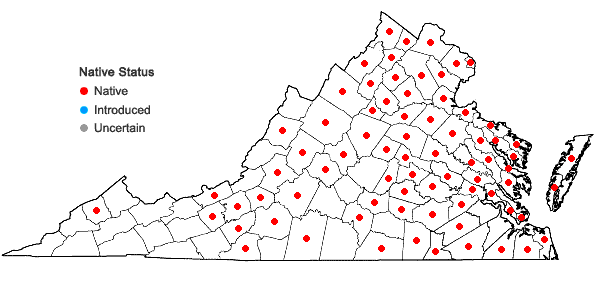Viburnum dentatum complex
No images available.

Detail
- Family
- Viburnaceae
- Botanical Name
- Viburnum dentatum complex
- Common Name
- Arrow-wood
- Synonym(s)
- Flora of Virginia Name/Status
- Viburnum dentatum L. + Viburnum recognitum Fern.
- Comments
- The map contains records for both Viburnum dentatum (sensu stricto) and V. recognitum (= V. dentatum var. lucidum), which have often been lumped in previous Virginia floristic studies. These taxa are among approximately 10 species (most of the others outside our area) that constitute the Viburnum dentatum complex of similar taxa that can be quite variable and distinguished primarily by differences in petiole length, leaf morphology, glandularity, and differing types and distribution of pubescence. Flora of the Southeastern U.S. states that a number of taxonomic problems remain in the complex and that their treatment is provisional.
The two species in Virginia vary in pubescence, with V. recognitum glabrate, usually with a few non-stellate hairs on the leaf undersides; by contrast, V. dentatum has the petioles and leaf undersides sparsely to moderately stellate-pubescent. The two appear to intergrade to some degree in our area, and specimens of equivocal character (e.g., with just a few stellate hairs and mostly non-stellate hairs) are occasionally encountered. Viburnum dentatum is reported to range generally east of the Appalachians, while V. recognitum is more widespread; however, it appears that the two taxa are widely distributed and largely sympatric in Virginia. Incomplete maps are provided for the two species, but more extensive field and herbarium work will be required to accurately and fully map them.
Both the Southern Appalachian Viburnum carolinianum Ashe and the northern V. venosum Britt. have been attributed to Virginia, but evidence is either lacking or equivocal and needs further investigation. See also the map for Viburnum rafinesquianum J.A. Schultes, a morphologically distinctive member of the complex that is unlikely to be confused with other species.
- Habitat
- As a whole, plants of this complex occur in mesic to dry upland forests, bottomland forests, wet flatwoods, seepage swamps, fens, alluvial and tidal swamps, upland depression swamps, and rocky riverside bars. They are frequent to common throughout, except in far sw. Virginia, but the relative distribution, abundance, and habitats of the two species are incompletely known.
- Native Status
- Native
To save this map, right-click (control-click for Mac users) on the map and choose "Save Image As...".